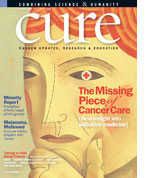Cancer Around the World
The current state of cancer incidence and prevention in developing countries.
Lack of public education in cancer prevention strategies, fewer state-of-the-art health facilities, and a shortage of health care professionals are all contributing factors in the mounting cancer mortality rates in economically strapped countries.
It is estimated that there were 12 million new cases of cancer worldwide in 2007, with more than half, 6.7 million, occurring in developing countries, according to the American Cancer Society. And of the 7.6 million people who died from the disease, nearly five million of those deaths occurred in developing countries. By 2050, the ACS predicts the number of cancer cases worldwide will grow to a staggering 27 million, making cancer the second leading cause of death in less developed countries, after heart disease.
“Because some of the developing countries are able to control infections, more of the population is living longer and living to the ages in which they are at higher risk for getting cancer,” says Lynn Ries, a health statistician at the National Cancer Institute.
Increases in tobacco use and the number of people who smoke—according to the World Health Organization, there are more than 350 million smokers in China alone—and limited control over cancer-causing infections (hepatitis B virus and Helicobacter pylori bacterium) have led to higher rates of lung, liver, and stomach cancer, respectively, in the developing world.
“More than 80 percent of liver cancer cases occur in developing countries and a lot of that is due to risk associated with hepatitis B and hepatitis C [because] those viruses are more prevalent in some developing countries than they are in developed countries,” says Ries.
Cervical cancer is found in higher numbers in India, China, and Southeast Asia, and about 80 percent of all women who die of the disease live in developing countries. Pap screening, DNA testing for human papillomavirus, and vaccination against HPV are less accessible and unaffordable for many.
A number of national and international health organizations are now coming together to find ways to eliminate some of the barriers that are preventing a reduction in cancer incidence and mortality in poor countries.
The Breast Health Global Initiative, whose members include the American Society of Clinical Oncology and the National Cancer Institute, is devising breast cancer treatment guidelines that can be customized based on a country’s economic and medical resources to improve breast cancer outcomes. The two organizations are also coordinating programs designed to share medical information with health care professionals in developing nations.
At the 2007 Clinton Global Initiative, Merck committed to donate at least three million doses of its HPV vaccine Gardasil over a five-year period to support vaccination programs in low-income nations. Also in 2007, the International Union Against Cancer launched a five-year cancer prevention campaign called “Today’s Children, Tomorrow’s World” to target parents, health care professionals, and policymakers with messages about smoke-free environments, diet, exercise, avoiding sun overexposure, and vaccines to prevent liver and cervical cancers.
